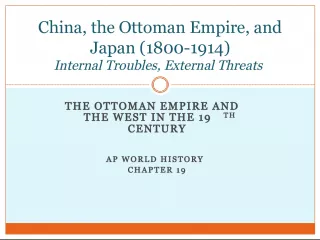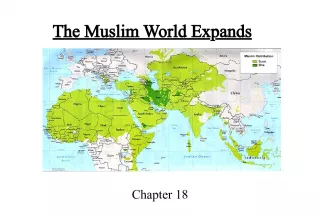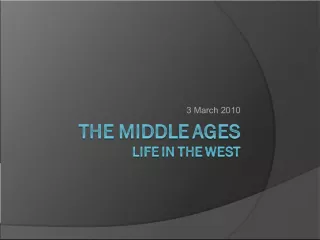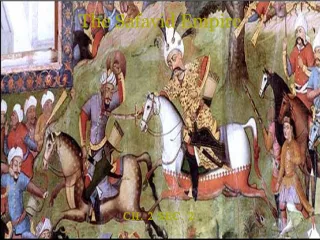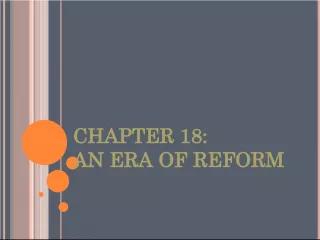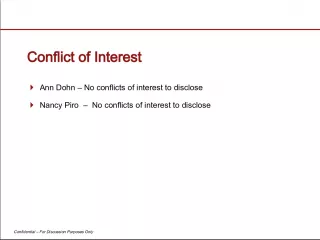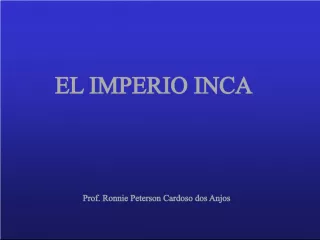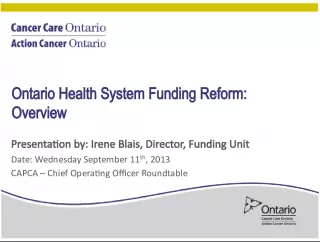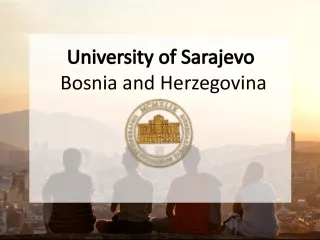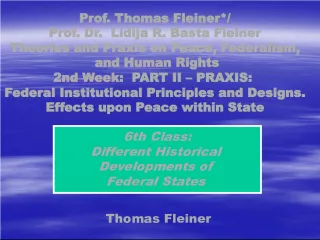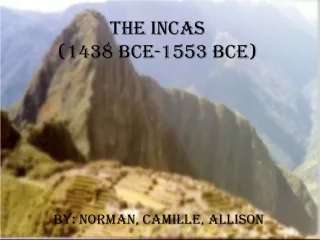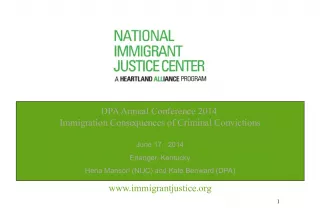The Tanzimat Reform Era in the Ottoman Empire


This article discusses the period of reform in the Ottoman Empire from 1839 to 1876 known as the Tanzimat era, which aimed to reorganize the empire's administration and military along European lines.
- Uploaded on | 0 Views
-
 ivethboyer
ivethboyer
About The Tanzimat Reform Era in the Ottoman Empire
PowerPoint presentation about 'The Tanzimat Reform Era in the Ottoman Empire'. This presentation describes the topic on This article discusses the period of reform in the Ottoman Empire from 1839 to 1876 known as the Tanzimat era, which aimed to reorganize the empire's administration and military along European lines.. The key topics included in this slideshow are Ottoman Empire, reform, Tanzimat, Hatt-i Sharif, European influence,. Download this presentation absolutely free.
Presentation Transcript
1. 2006 Pearson Education, Inc. The period of reform in the Ottoman Empire that lasted from 1839 to 1876 is known as the: 1. Tanzimat 2. Era of Self-Strengthening 3. New Birth 4. Hatt-i Sharif 22.01 Q
2. 2006 Pearson Education, Inc. The period of reform in the Ottoman Empire that lasted from 1839 to 1876 is known as the: 1. Tanzimat 2. Era of Self-Strengthening 3. New Birth 4. Hatt-i Sharif 22.01 A
3. 2006 Pearson Education, Inc. EXPLANATION: The period of reform in the Ottoman Empire that lasted from 1839 to 1876 is known as the: 1. Tanzimat In 1839, under pressure from imperial bureaucrats who had studied in Europe, the sultan issued a decree, called the Hatt-i Sharif of Glhane , that attempted to reorganize the empires administration and military along European lines. This decree opened what became known as the Tanzimat (meaning reorganization) era of the Ottoman Empire, lasting from 1839 to 1876. 22.01 E
4. 2006 Pearson Education, Inc. Camillo Cavour was the prime minister of: 1. Galicia 2. Piedmont 3. Tuscany 4. Naples 22.02 Q
5. 2006 Pearson Education, Inc. Camillo Cavour was the prime minister of: 1. Galicia 2. Piedmont 3. Tuscany 4. Naples 22.02 A
6. 2006 Pearson Education, Inc. EXPLANATION: Camillo Cavour was the prime minister of: 2. Piedmont By 1860, the Italian peninsula was transformed into a nation-state under a constitutional monarchy. Count Camillo Cavour (18101861), the prime minister of Piedmontnot of romantic republicansmade this possible. 22.02 E
7. 2006 Pearson Education, Inc. In the 1850s, the two most powerful German- speaking states were: 1. Austria and Saxony 2. Bavaria and Saxony 3. Prussia and Bavaria 4. Austria and Prussia 22.03 Q
8. 2006 Pearson Education, Inc. In the 1850s, the two most powerful German- speaking states were: 1. Austria and Saxony 2. Bavaria and Saxony 3. Prussia and Bavaria 4. Austria and Prussia 22.03 A
9. 2006 Pearson Education, Inc. EXPLANATION: In the 1850s, the two most powerful German- speaking states were: 4. Austria and Prussia The two by far strongest states were Austria and Prussia. During the 1850s, Austria presided over the diet of the German Confederation. The major states continued to trade with each other through the Zollverein (tariff union), and railways linked their economies. 22.03 E
10. 2006 Pearson Education, Inc. What German-speaking country did Bismarck intend to exclude from a united Germany? 1. Alsace 2. Schleswig Holstein 3. Bavaria 4. Austria 22.04 Q
11. 2006 Pearson Education, Inc. What German-speaking country did Bismarck intend to exclude from a united Germany? 1. Alsace 2. Schleswig Holstein 3. Bavaria 4. Austria 22.04 A
12. 2006 Pearson Education, Inc. EXPLANATION: What German-speaking country did Bismarck intend to exclude from a united Germany? 4. Austria Bismarcks vision of a united Germany did not include all Germanspeaking lands. That is to say, he pursued a kleindeutsch , or small German, solution to unification. He intended to exclude Austria from any future united German state. This goal required complex diplomacy. 22.04 E
13. 2006 Pearson Education, Inc. The newly-elected French National Assembly of 1871 was dominated by: 1. socialists 2. radicals 3. monarchists 4. liberals 22.05 Q
14. 2006 Pearson Education, Inc. The newly-elected French National Assembly of 1871 was dominated by: 1. socialists 2. radicals 3. monarchists 4. liberals 22.05 A
15. 2006 Pearson Education, Inc. EXPLANATION: The newly-elected French National Assembly of 1871 was dominated by: 3. monarchists The division between the provinces and Paris became sharper after the fighting with Germany stopped. Monarchists dominated the new National Assembly elected in February. For the time being, the assembly gave executive power to Adolphe Thiers (17971877), who had been active in French politics since 1830. 22.05 E
16. 2006 Pearson Education, Inc. The Dual Monarchy of Austria-Hungary was established by the: 1. February Patent 2. Compromise of 1867 3. October Diploma 4. May Accords 22.06 Q
17. 2006 Pearson Education, Inc. The Dual Monarchy of Austria-Hungary was established by the: 1. February Patent 2. Compromise of 1867 3. October Diploma 4. May Accords 22.06 A
18. 2006 Pearson Education, Inc. EXPLANATION: The Dual Monarchy of Austria-Hungary was established by the: 2. Compromise of 1867 The Ausgleich , or Compromise, of 1867 transformed the Habsburg Empire into a dual monarchy known as Austria-Hungary. 22.06 E
19. 2006 Pearson Education, Inc. What country did Austria compete with for influence in the Balkans? 1. Germany 2. Italy 3. Britain 4. Russia 22.07 Q
20. 2006 Pearson Education, Inc. What country did Austria compete with for influence in the Balkans? 1. Germany 2. Italy 3. Britain 4. Russia 22.07 A
21. 2006 Pearson Education, Inc. EXPLANATION: What country did Austria compete with for influence in the Balkans? 4. Russia The weakness of the Ottoman Empire allowed both Austria and Russia to compete in the Balkans for influence and thus further inflame nationalistic resentments. 22.07 E
22. 2006 Pearson Education, Inc. In 1894 Captain Alfred Dreyfus was found guilty of: 1. passing secrets to the Germans 2. embezzling funds from the French army 3. conducting unauthorized secret talks with Russia 4. crimes against humanity 22.08 Q
23. 2006 Pearson Education, Inc. In 1894 Captain Alfred Dreyfus was found guilty of: 1. passing secrets to the Germans 2. embezzling funds from the French army 3. conducting unauthorized secret talks with Russia 4. crimes against humanity 22.08 A
24. 2006 Pearson Education, Inc. EXPLANATION: In 1894 Captain Alfred Dreyfus was found guilty of: 1. passing secrets to the Germans On December 22, 1894, a French military court found Captain Alfred Dreyfus (18591935) guilty of passing secret information to the German army. The evidence against him was flimsy and was later revealed to have been forged . 22.08 E
25. 2006 Pearson Education, Inc. The new Russian provincial and county councils organized in 1864 were known as: 1. zasus 2. dumas 3. zemstvos 4. soviets 22.09 Q
26. 2006 Pearson Education, Inc. The new Russian provincial and county councils organized in 1864 were known as: 1. zasus 2. dumas 3. zemstvos 4. soviets 22.09 A
27. 2006 Pearson Education, Inc. EXPLANATION: The new Russian provincial and county councils organized in 1864 were known as: 3. zemstvos The nobility were given a large role in local administration through a system of provincial and county zemstvos , or councils, organized in 1864. These councils were to oversee local matters, such as bridge and road repair, education, and agricultural improvement. The zemstvos , however, were underfunded, and many of them remained ineffective. 22.09 E
28. 2006 Pearson Education, Inc. Alexander III sought to: 1. introduce democracy to Russia 2. roll back his fathers reforms 3. continue his fathers reforms 4. establish closer relations between Russia and China 22.10 Q
29. 2006 Pearson Education, Inc. Alexander III sought to: 1. introduce democracy to Russia 2. roll back his fathers reforms 3. continue his fathers reforms 4. establish closer relations between Russia and China 22.10 A
30. 2006 Pearson Education, Inc. EXPLANATION: Alexander III sought to: 2. roll back his fathers reforms Alexander III possessed all the autocratic and repressive characteristics of his grandfather, Nicholas I, and none of the better qualities of his father, Alexander II. Some slight improvements were made to conditions in Russian factories, but Alexander III sought primarily to roll back his fathers reforms. 22.10 E
31. 2006 Pearson Education, Inc. Gladstones ministry of 1868 to 1874 witnessed the: 1. culmination of classical British liberalism 2. introduction of socialism into British national policy 3. complete collapse of liberalism 4. high point of British conservatism 22.11 Q
32. 2006 Pearson Education, Inc. Gladstones ministry of 1868 to 1874 witnessed the: 1. culmination of classical British liberalism 2. introduction of socialism into British national policy 3. complete collapse of liberalism 4. high point of British conservatism 22.11 A
33. 2006 Pearson Education, Inc. EXPLANATION: Gladstones ministry of 1868 to 1874 witnessed the: 1. culmination of classical British liberalism Gladstones ministry of 1868 to 1874 witnessed the culmination of classical British liberalism. Those institutions that remained the preserve of the aristocracy and the Anglican church were opened to people from other classes and religious denominations. 22.11 E
34. 2006 Pearson Education, Inc. Disraelis efforts at social reform focused on: 1. individualism 2. free trade 3. family life 4. paternalistic legislation 22.12 Q
35. 2006 Pearson Education, Inc. Disraelis efforts at social reform focused on: 1. individualism 2. free trade 3. family life 4. paternalistic legislation 22.12 A
36. 2006 Pearson Education, Inc. EXPLANATION: Disraelis efforts at social reform focused on: 4. paternalistic legislation The two men differed on most issues. Whereas Gladstone looked to individualism, free trade, and competition to solve social problems, Disraeli believed in paternalistic legislation to protect the weak and ease class antagonisms. 22.12 E
37. 2006 Pearson Education, Inc. The Irish Question centered on the issue of: 1. economic equality 2. religious toleration 3. home rule 4. the rights of Irish residents of England 22.13 Q
38. 2006 Pearson Education, Inc. The Irish Question centered on the issue of: 1. economic equality 2. religious toleration 3. home rule 4. the rights of Irish residents of England 22.13 A
39. 2006 Pearson Education, Inc. EXPLANATION: The Irish Question centered on the issue of: 3. home rule The major issue of the 1880s, however, was Ireland. From the late 1860s onward, Irish nationalists had sought to achieve home rule for Ireland, by which they meant Irish control of local government. 22.13 E
